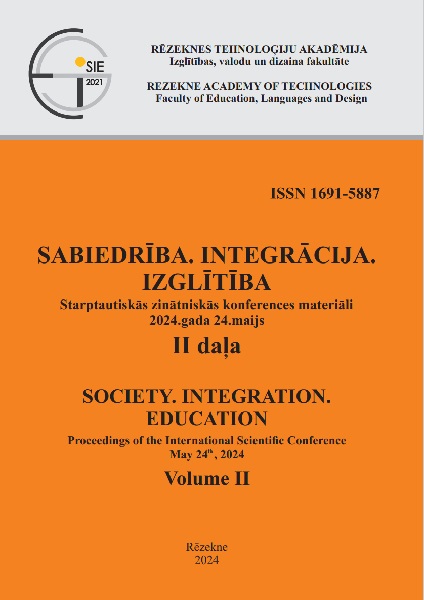THE THE WORD CHAIN TEST: THE NORMATIVE DATA FOR STUDENTS FROM GRADES 1 TO 9
DOI:
https://doi.org/10.17770/sie2024vol2.7867Keywords:
dyslexia, normative data, reading disorders, screening, visual-spatial functions, Word Chain Test, word decodingAbstract
The Word Chain Test (WCT) is a rapid screening procedure that appears to identify primary and secondary school students with poor silent word decoding abilities. The WCT was adapted to the Latvian language in 2003. However, norms for the test had yet to be established. The study is aimed to develop the WCT normative data set for students from grades 1 to 9. Students from grades 1 to 9 (N = 4476) representing all geographical regions of Latvia, urban and country territories completed the WCT that included two subtests – letter chains and word chains. The descriptive statistic parameters were estimated for each grade. The results demonstrated statistically significant correlations between scores of word and letter chains and the age of students. The statistically significant differences in the average scores of letter and word chains were found between boys and girls. The scores of letter and word chains were scaled separately for boys and girls by grade using a standard nine-point scale. The 5th, 7th, and 16th percentiles were estimated for diagnostic purposes. The developed WCT normative data set allows the examiner to assess students' visual-spatial and word-decoding skills. Future studies should continue the standardization procedures by determining the convergent and clinical validity of the WCT.
References
Alm, J. (2004). Dyslexia: Relevance of concepts, validity of measurements, and cognitive functions (Doctoral dissertation). Uppsala University, Uppsala, Sweden.
Centrālās statistikas pārvalde (CSP). (2022). Izglītojamo skaits vispārizglītojošās dienas skolās pa klasēm (mācību gada sākumā). Pieejams: https://data.stat.gov.lv/pxweb/lv/OSP_OD/OSP_OD__sociala__izgl__vispskolas/IZG090.px/
Dimitra, S. (2023). Developmental dyslexia: Convergence of all theories towards a multifactional model, and the role of ICTs. GSC Advanced Research and Reviews, 2023,17 (01), 047-060 DOI: https://doi.org/10.30574/gscarr.2023.17.1.0386
Erbeli, F., Rice, M., & Paracchini, S. (2021). Insights into dyslexia genetics research from the last two decades. Brain Sciences, 12(1), 27. DOI: 10.3390/brainsci12010027.
Famula-Jurczak, A. & Perzanowska, K. (2023). Developmental dyslexia – it's (not) a problem. Journal of Vasyl Stefanyk Precarpathian National University. Vol. 10, No. 1 (2023), 133-143 doi: 10.15330/jpnu.10.1.133-143
Flannery, K.A., Liederman, J., Daly, L., & Schultz, J. (2000). Male prevalence for reading disability is found in a large sample of Black and White children free from ascertainment bias. Journal of the International Neuropsychological Society, 6(4), 433-442.
Jacobson, C. (1995). Word Recognition Index (WRI) as a quick screening marker of Dyslexia. The Irish Journal of Psychology, 16(3), 260-266. DOI: 10.1080/03033910.1995.10558061
Jacobson, C. (1997). Manual Ordkedjor [Manual Word Chains, revised edition]. Stockholm: Psykologiförlaget.
Jacobson, C. (2001). Läskedjor Manual. Stockholm: Hogrefe Psykologiförlaget AB.
Jacobson, C. (2014). LäsKedjor-2. För skolår 1 – år 1 i gymnasiet. Stockholm: Hogrefe Psykologiförlaget AB.
Mattson, E H., Fischbein, S., & Roll-Pettersson, L. (2010). Students with reading difficulties/dyslexia: a longitudinal Swedish example.International Journal of Inclusive Education. Vol. 14, No. 8, December 2010, 813-827 DOI: 10.1080/13603110902721662
Peterson, R. L., & Pennington, B. F. (2012). Developmental dyslexia. Lancet, 379(9830), 1997-2007.
Scorza, M., Benassi, E., Boni, C. D., & Stella, G. (2019). The Word Chain Test: a short collective screening for identification at risk for reading disabilities. TPM, 26(1), 5-27.
Scorza, M., Boni, C. D., Scortichini, F., Mortini, I., & Stella, G. (2015). Letter chain e word chain. Un nuovo strumento di screening per l'identificazione dei bambini con difficolta di lettura. DISLESSIA. Vol. 12, n. 3, ottobre 2015 287-301
Tordön, R., Bladh, M., Svedin, C. G., & Sydsjö, G. (2020). Challenging intellectual, behavioral and educational prerequisites for interventions aimed at school aged children in foster care. A compilation of Swedish test results. Children and Youth Services Review, 108. DOI: https://doi.org/10.1016/j.childyouth.2019.104598.
Verhoeven, L., & van Leeuwe, J. (2011). Role of gender and linguistic diversity in word decoding development, Learning and Individual Differences, 21(4), 359-367.
Wagner, R.K., Zirps, F.A., Edwards, A. A., Wood, S. G., Joyner, R. E., Becker, B. J., Liu, G., & Beal, B. (2020). The prevalence of dyslexia: a new approach to its estimation. Journal of Learning Disabilities, 53(5), 354-365.
Zhang, D., Lu, B., Guo, J., He, Y., & Liu, H. (2023). Assessment of Visual Motor Integration via Hand-Drawn Imitation: A Pilot Study. Electronics, 12, 2776. https:doi.org/10.3390/electronics12132776






